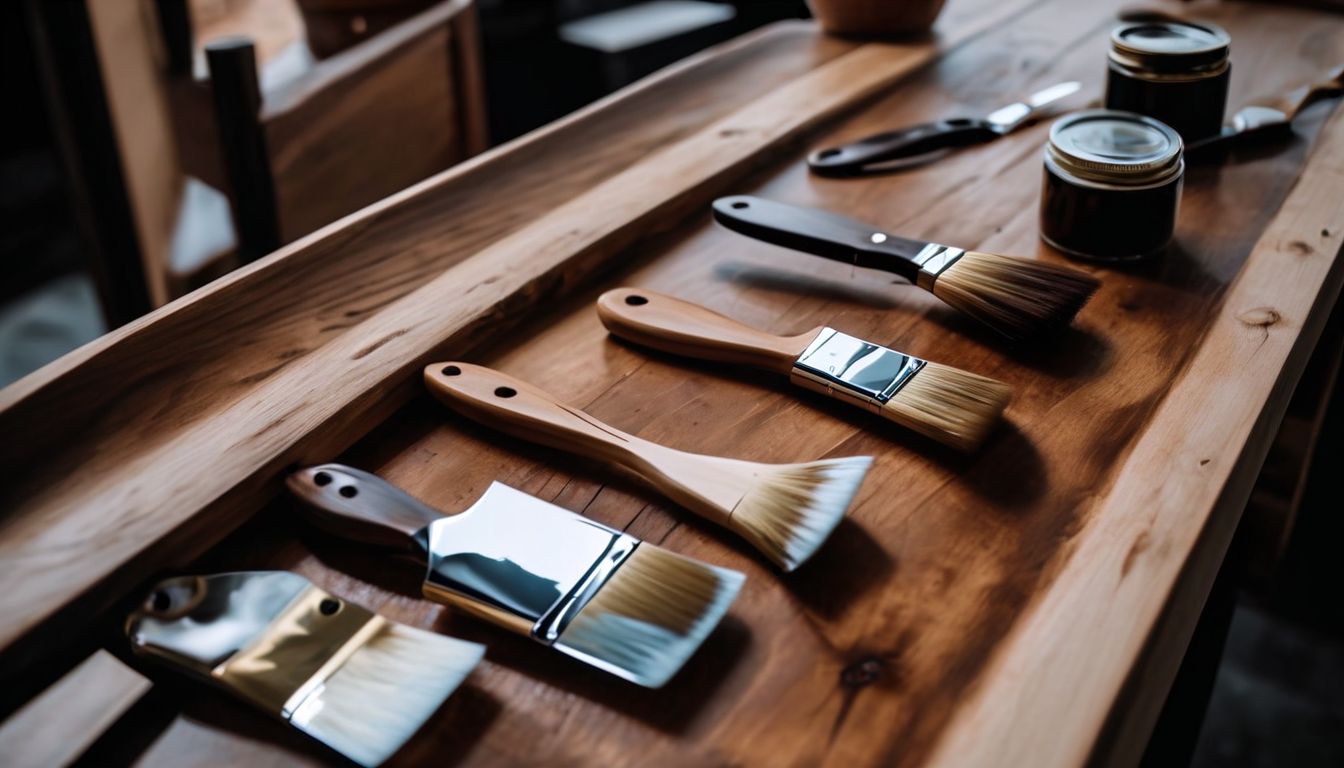
What is the best paint for furniture? We’ve talked a lot about how to make your home look amazing. From painting walls and floors to radiators and skirting boards, there are a lot of options if you’re looking to spruce things up.
But if your furniture is looking tired, it can let the side down, no matter how good the rest of the room looks!
To solve this problem, today we’ll explain how you can rejuvenate your old furniture and make it look fantastic.
Key Takeaways:
- Painting furniture is a great way to express yourself and complement the rest of your home.
- There are a wide range of paints to choose from including latex, oil-based, acrylic, and more!
- Preparing the surface correctly is crucial to get the right finish.
- Follow our guide for the best results!
Should you Paint Furniture?
Buying new furniture is costly and can be tricky if you have a distinct theme for your home. A fresh coat of paint is a cheap alternative to buying new pieces and also means you won’t get rid of the furniture you’ve grown attached to.
Painting your furniture is a great way to express yourself. If you like bold colours, wooden furniture can be a black canvas. And if you don’t want to go too bold, simply changing the shade will not only make the furniture look new, but unique too.
But before you start rollering your sofa cushions, it’s important to know what parts of furniture are suitable for painting and which should be left alone.
What Furniture can be Repainted?
Most wooden or metal furniture can be painted. You can paint straight onto the surface, but if it has been painted previously the finish won’t be ideal. The trick is to sand the surface down first.
By sanding wooden surfaces, you’ll remove any previous layers of paint and varnish, and the new layers you add will cling to the wood better.
If you’re new to interior decorating, painting older furniture can be a great way to practice before you commit to walls or other large areas. If you have furniture that you were considering getting rid of, why not use it to develop your painting skills instead?
The Best Paint for Furniture
There are multiple types of paint that can be used to reinvigorate your tired furniture. These include:
- Latex Paint
- Oil-Based Paint
- Acrylic Paint
- Milk Paint
- Chalk Paint
They all have their advantages and disadvantages, so let’s go over them one at a time.
Latex Paint for Furniture
Latex paint is a popular choice for painting furniture because of its versatility. Unlike other types of paint we’ll talk about, latex paint comes in a wide range of finishes: matte, satin, semigloss, and gloss. This means that if you want a specific sheen level for your furniture, there will often be a latex paint option that matches your vision.
However, latex paint isn’t particularly hardwearing. This means that the paint is prone to chipping and scratching over time, not ideal if the piece of furniture will be used or moved around a lot. It also takes a while to fully dry, which should be kept in mind when you plan your painting time.
Oil-Based Paint for Furniture
If you want a durable paint for your furniture, oil-based paint is the toughest around. It clings to the surface well, creating a strong barrier against scuffs and scratches. They also have a naturally high sheen, so if you want a glossier finish, oil-based paints are a great choice.
However, there is a price to pay for this toughness. Oil-based paints have high levels of VOCs, meaning they need to be painted in a well-ventilated area. As they also take a long time to dry, this can make finding somewhere to use your oil-based paint awkward.
Acrylic Paint for Furniture
As with almost every painting project, acrylic paint is a solid choice for painting furniture. Available in a wide range of colours, if you want to be bold, acrylic is the paint for you. Despite being water-based, the durability is better than most, and the surface is easy to clean with soap, water, and a bit of elbow grease. Most acrylic paints are non-toxic, and they are the best choice for beginners.
Acrylic paint’s biggest weakness is that you’ll need to pair it with a primer and use multiple layers for the best finish. It dries quickly though, so this shouldn’t eat into your painting time too badly.
Milk Paint and Chalk Paint for Furniture
These two paint options are more niche, so let’s talk about them together. These are paints that are primarily used for furniture painting but have applications elsewhere.
Chalky paint is especially popular if you’re trying to freshen up old furniture while trying to retain the old-world charm. It creates a finish that looks like it has been sanded or has been used for a long time. It is latex based, but thicker, giving it more durability.
Milk paint creates a similar finish but is slightly thinner due to being water-based. Using a bonder is recommended for a consistent finish, which makes this a type of paint that isn’t as beginner friendly. It does offer a lot of options once the paint as dried, as milk paint can be sanded or waxed for extra preservation or a specific look.
How to Paint Furniture – Furniture Painting Guide
Once you know what paint is right for you, don’t jump straight into painting until you know how to get the most out of it. Missing a step in the painting process will send you back to square one with little to show for it.
Don’t worry, we’re here to help!
Follow our guide below and your furniture will look fantastic in no time. Be sure to read it through a few times before you start, so there are no surprises.
Here’s what you’ll need to paint your furniture:
- Paint
- Primer
- Paint Brush and/or Paint Roller
- Sandpaper
- Dust Sheets
STEP 1 – Preparing Furniture for Painting
The first thing to do is give yourself plenty of room to work. Choose an open area, close to a window or patio door for ventilation and lay out some dust sheets or old towels to keep your floors clean.
If you’re painting a large piece of furniture such as a dresser or wardrobe, you may choose to paint a side at a time or do it all at once. The latter is often better as you’ll be able to keep the finish more consistent.
Next, give the item a thorough clean. This can be done with soap, water, and a bit of elbow grease. By cleaning the surface your paint and primer will cling to the surface better and no grime or imperfections will show through.
STEP 2 – Sanding Furniture for Painting
Next, you need to sand down the surface. There’s no need to sand all the way down to bare wood, just remove the glossy top layer. Or if the item is quite old, and has lost its sheen over time, you can skip sanding and move on.
STEP 3 – Priming Furniture for Painting
Not all paint types need to be paired with a primer, but we always recommend adding a layer of water-based primer before you paint. Primer gives the paint a smooth surface to cling to, meaning the sheen and colour of your paint will be brighter and bolder.
Apply a single, even layer, being sure to overlap your strokes so every inch gets covered.
STEP 4 – Painting Furniture
Now for the fun part. Always test your paint in an inconspicuous area first to see how it looks.
Once your primer has dried, apply your first coat of paint in a similar way, overlapping each stroke. This will be easier with a paint roller, but will prevent you from reaching trickier areas, so using both roller and brush gets the best results.
If you’re painting something small such as a chair, a medium size paint brush will get the job done.
The number of layers you’ll need depends on the type of paint you’ve chosen. Consult the manufacturer instructions for the recommended number, and how long each layer will take to dry.
STEP 5 – Admire your Work
Once the final layer has dried, take a step back and take a look at your freshly painted piece of furniture. How does it look?
The UK’s Most Trusted Paint Supplier
Painting furniture is very satisfying and a great way to improve your painting skills. If you’re all about self-expression, paint your furniture to show off your style!
We’re the no.1 choice for tradespeople, with large quantities of paint available at competitive prices, and we’re loved by domestic painters too!
Check out our blog for more information, advice and guides about all things painting. If you have any questions about any of our products, please get in touch.
We look forward to hearing from you.
FAQ's
Can I paint over varnished wood?
Varnished wood surfaces can be painted, but you need the right paint for the job. Oil and water-based paints are essential, with a layer of primer to ensure it clings to the wood. You should also sand the surface first to remove the gloss.
Can I use wood paint on furniture?
Most wood paints work on wooden furniture, which is a great way to use up any excess you have from a bigger project. However, specialised furniture paint will be better overall, whereas regular wood paint is best for touch-ups.
Do you have to sand furniture before painting?
If you want to paint your wooden furniture without sanding down the surface first, chalk paint is best. Specialist furniture paint works too. However, if the surface is rough and worn, you should consider sanding it first if you want it to look like new.
Do you need to prime before using furniture paint?
If the furniture you are painting requires extra adhesion, a layer of primer will help your paint to cling to the surface. However, some paints have a priming agent in their compound that will have a similar effect, but not as pronounced as a separate layer. Priming helps add protection to the surface, as well as making colour and sheens stand out more.
Is it best to paint furniture with a brush or roller?
If your furniture piece has large, flat surfaces (such as a dresser, table, or wardrobe) a paint roller can help you cover a lot of space more easily. However, for the fiddlier parts, a paint brush is essential to guarantee an even coverage.
What is the best paint to use on furniture?
Wooden furniture can be painted with a range of paints, all with their pros and cons. Latex, oil-based, acrylic, as well as milk and chalk paint can all be used on furniture. Acrylic paint is the most popular, as it is beginner-friendly and has the most colour options.
